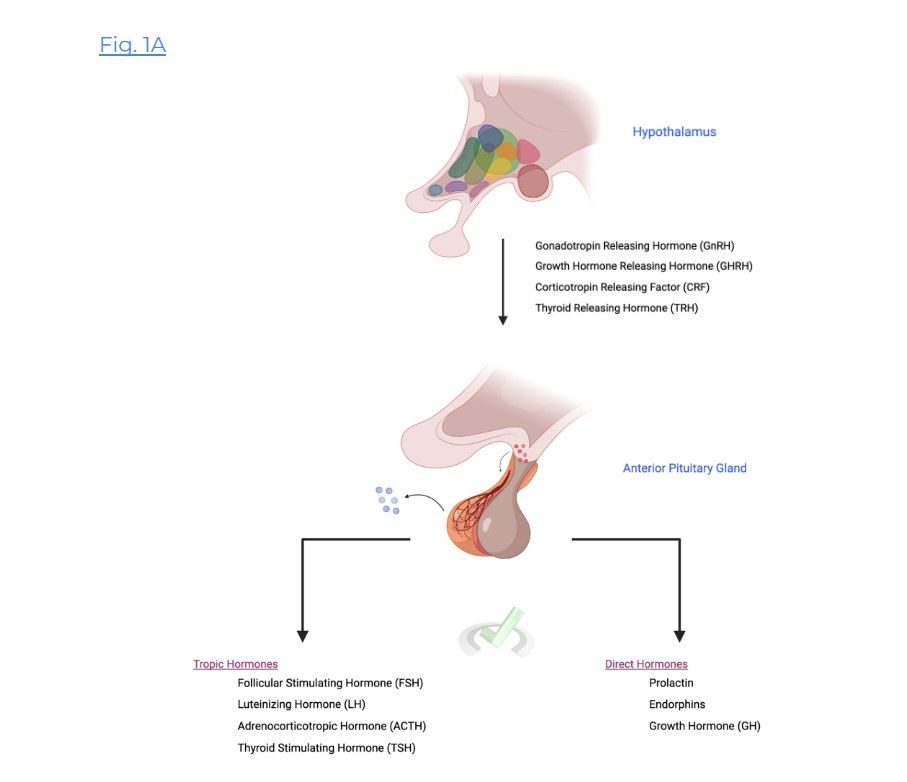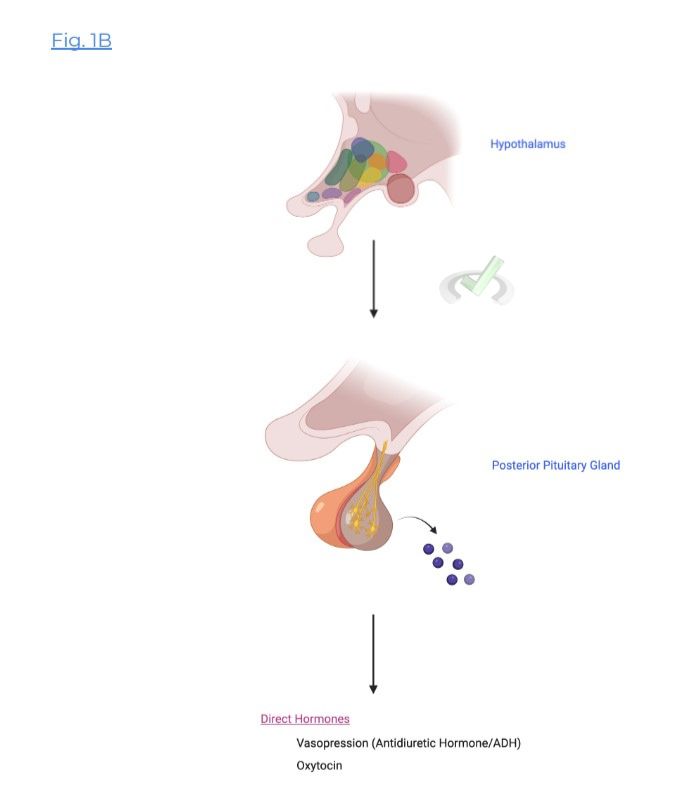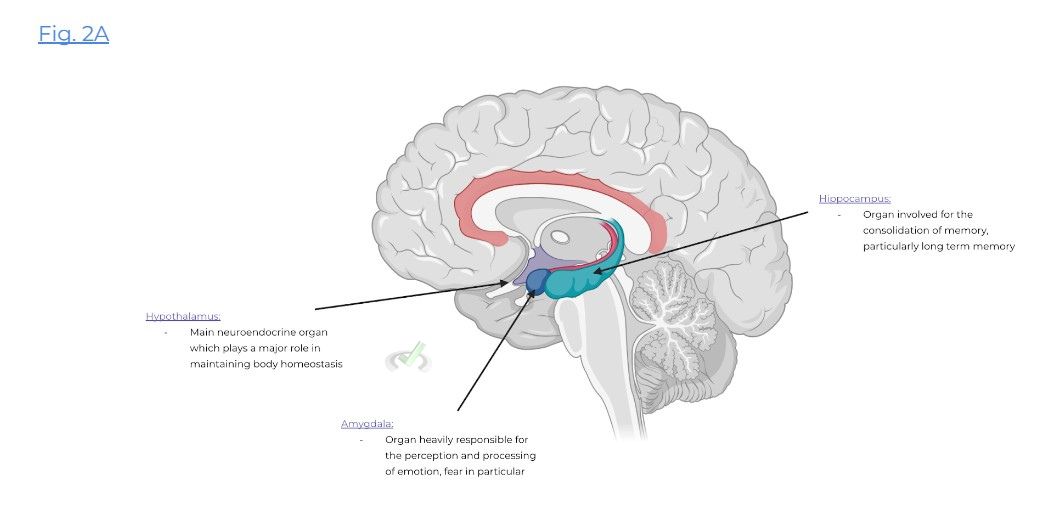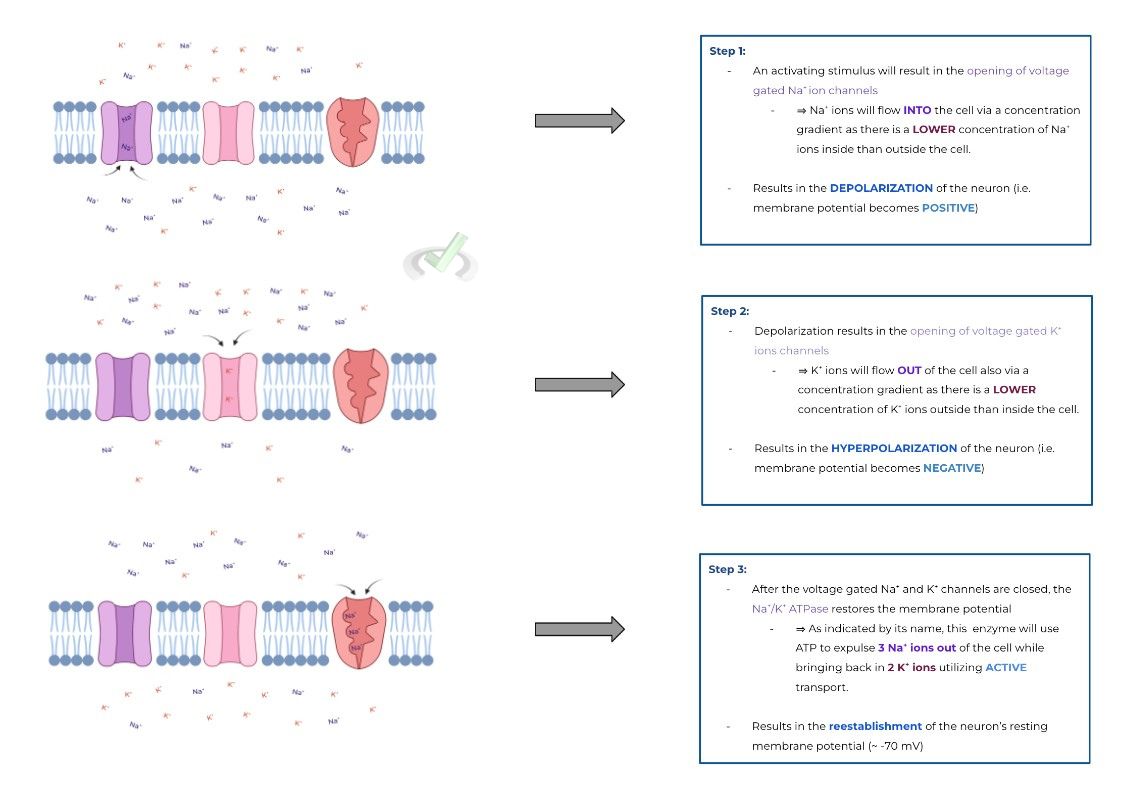I. What are Hypothalamic-Pituitary Interactions?
Aside from being a pretty badass set of words to pronounce to feel sophisticated, hypothalamic-pituitary interactions are the starting point for most endocrine and hormonal interactions. When reading and reviewing the other study articles about hormones, you’ll see that a lot of these outcomes and hormone releases will start with hypothalamic-pituitary interactions.
These interactions are exactly what they sound like: they refer to how the hypothalamus will stimulate the anterior and posterior pituitary glands in order to release their respective hormones. When studying and reviewing this article, pay special attention to the hormones that are released and their type (i.e direct v.s. tropic) as we discussed in previous articles.
It’s also important to understand that the interactions with the hypothalamus allows for the endocrine system to have a neuro component, hence why the hypothalamus is also referred to as a neuroendocrine organ within the endocrine system.
II. Content Review
Let’s start with some basic anatomy and descriptions: the hypothalamus is a neuro organ which lies just below the thalamus . Likewise, the pituitary glands lie just below the hypothalamus and are tasked with housing the hormones which will be released upon stimulation from the hypothalamus. We’ll split the hypothalamus interactions into those between the anterior and posterior pituitary gland.
A. Hypothalamic-Anterior Pituitary Interactions
In order to interact with the anterior pituitary, the hypothalamus will utilize the hypophyseal portal system, which is a series of blood vessels connecting the hypothalamus to the anterior pituitary gland.
Specifically, the hypophyseal portal system has a set of capillaries in the hypothalamus and anterior pituitary which are then connected by bigger blood vessels.
The hypothalamus produces various tropic hormones which will then utilize the hypophyseal portal system to travel to the anterior pituitary to interact with the receptors on secretory granules, allowing for the release of other hormones.

The tropic hormones released by the hypothalamus and the hormones they release include:
Note!:
- Not all of the hormones released by the anterior pituitary gland will require the release of hypothalamic tropic hormones (i.e. as in the case for endorphins)
B. Hypothalamic-Posterior Pituitary Interactions
As opposed to the anterior pituitary, the posterior pituitary will interact with the hypothalamus via nerve tracts which originate from the hypothalamus.
Instead of tropic hormones, the posterior pituitary is stimulated by the action potentials from the nerve tracts which then causes the release of the stored hormones.

III. Bridge/Overlap
As stated above, it’s important to recognize that the hypothalamus functions as a neuroendocrine organ and as a medium to allow for the nervous and endocrine system to interact with one another. Let’s take this time to learn a little more about the hypothalamus and see how we can make connections to other MCAT topics.
In addition to helping the body maintain homeostasis, the hypothalamus is also a part of the limbic system: a collection of brain organs which are involved in the processing & understanding of emotions and memory.
Though containing many structures, the most important structures to be familiar with are the hypothalamus, hippocampus, and amygdala. You’ll learn more about neuroanatomy and function in other articles!

Just like the thalamus, the hypothalamus also has various nuclei! Just as a little refresher, nuclei basically refers to a group of neural cell bodies in the CNS working to accomplish a specific function.
In fact, it is actually the supraoptic and paraventricular nuclei of the hypothalamus which produce vasopressin and oxytocin, respectively. Since we’re talking about tracts and action potentials, it may also be of use to briefly review the process of an action potential which we’ve listed below!

IV. Wrap Up/Key Terms
Let’s take this time to wrap up & concisely summarize what we covered above in the article!
Hypothalamic-Pituitary Interactions:
Hypothalamic-Pituitary Interactions can be divided into those for the anterior pituitary gland and the posterior pituitary gland.
A. Hypothalamic-Anterior Pituitary Gland
The hypothalamus will utilize the hypophyseal-portal system in order to interact with the anterior pituitary gland.
This consists of a set of capillaries located in the hypothalamus and the anterior pituitary which are connected by blood vessels.
Tropic hormones released from the hypothalamus will travel through these blood vessels to interact with the anterior pituitary, causing the release of other hormones. These include:
Gonadotropin Releasing Hormone (GnRH) ⇒ Follicular Stimulating Hormone (FSH) & Luteinizing Hormone (LH)
Growth Hormone Releasing Hormone (GHRH) ⇒ Growth Hormone (GH)
Corticotropin Releasing Factor (CRF) ⇒ Adrenocorticotropic Hormone (ACTH)
Thyroid Releasing Hormone (TRH) ⇒ Thyroid Stimulating Hormone (TSH)
B. Hypothalamic-Posterior Pituitary Gland
The hypothalamus will utilize nerve tracts originating from its nuclei in order to stimulate the posterior pituitary.
Upon the generation of an action potential, the hormones stored within the posterior pituitary will be released. These include:
Vasopressin (Antiduretic/ADH)
Oxytocin
The hypothalamus is crucial as the mediator between the nervous and endocrine system. Aside from having roles in maintaining the body’s homeostasis, the hypothalamus also is a part of the limbic system, a collection of brain structures which are important in emotion and memory processing.
Like the thalamus, the hypothalamus also has multiple nuclei: the supraoptic and paraventricular nuclei are particularly important as they produce vasopressin and oxytocin, respectively.
V. Practice
Take a look at these practice questions to see and solidify your understanding!
Sample Practice Question 1:
The generation of an action potential within the hypothalamic tract will result in the release of which hormone(s)?
I. Oxytocin
II. ADH
III. Follicular Stimulating Hormone
A. I only
B. II only
C. I and III
D. I and II
Ans. D
Posterior pituitary interactions with the hypothalamus occur via nerve tract. Nerve tracts which originate in the hypothalamus will stimulate the release of the stored posterior pituitary hormones via an action potential.
Contrary to this, interactions between the hypothalamus and anterior pituitary gland will occur via the hypophyseal portal system and the release of tropic hormones from the hyp
The only 2 hormones that are housed in the posterior pituitary are 1) vasopressin (antidiuretic/ADH) and 2) oxytocin.
Sample Practice Question 2:
The gonadotropin releasing hormone (GnRH) released from the hypothalamus DOES NOT require a carrier protein in order to be transported in the hypophyseal portal system. What can be said about this hormone?
A. It is a steroid hormone.
B. It is a peptide hormone.
C. It can be either a steroid or peptide hormone.
D. Its precursor molecule is most likely cholesterol.
Ans. B
Look back to the different properties of peptide and steroid hormones in order to answer this question!
Remember that peptide hormones are generally polar and are thus soluble in the bloodstream which is why they don’t require a carrier protein.
Steroid proteins have a cholesterol backbone, conferring a hydrophobic, nonpolar nature which is why they DO require a carrier protein.
Because the question stem states that GnRH does not use a carrier protein, it is most likely a peptide hormone as it can be soluble in the bloodstream.



 To help you achieve your goal MCAT score, we take turns hosting these
To help you achieve your goal MCAT score, we take turns hosting these 
























